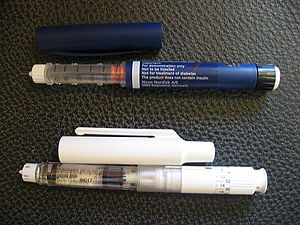Pancreatic Hormones
Pancreatic Hormones
Pancreas is both exocrine and endocrine gland. The exocrine part secretes pancreatic fluid into the duodenum after a meal. The endocrinal part secretes various types of hormones. These are produced by a specialized tissue in the pancreas and then released to the capillary system and transported into the liver by portal venous circulation. The specialized tissue of entodermic origin is called islets of Langerhans. Islets of Langerhans represent approximately 1-2 % of the pancreas. Four types of cells are regonized in these islets.
Types of pancreatic cells
- A cells – producing glucagon (25% of all islet cells).
- B cells – producing insulin (60% of all islet cells).
- D cells – producing somatostatin (10% of all islet cells).
- F cells – producing panceratic polypeptide (5% of all islet cells).
Islets of Langerhans play a crucial role in carbohydrate metabolism and so in a plasma glucose concentration. It involves:
- Glycolysis – the anaerobic/ aerobic conversion of glucose.
- Glycogenesis – the synthesis of glycogen from glucose (in liver, muscle).
- Glycogenolysis – breaking down glycogen to glucose.
- Gluconeogenesis – the production of glucose from non-sugar molecules (amino acids, lactate, glycerol).
- Lipolysis – the breakdown of triacylglycerols into glycerol and free fatty acids.
- Lipogenesis – the synthesis of triacylglycerols.
Hormones
Function
- Pancreatic hormones are responsible mainly for storage of glucose in form of glycogen.
- Enables the mobilisation of energy reserves as a result of food deprivation, stress, physical activity.
- Maintain the constant plasma glucose concentration.
- Stimulate growth.
Insulin
It is produced by pancreatic B-cells . Chemically, it is a peptide consisting of 51 amino acids.
Scheme: preproinsulin → proinsulin → insulin . Insulin secretion has pulsatile character and its main stimulus is a increased blood glucose level . Stimulation of secretion: increase in the level of plasma glucose → increase in the value of glucose in the B-cell → its oxidation increases and thus the amount of ATP in the cell → energy-controlled K+ channels close (depolarization occurs) → voltage-controlled Ca2+ channels open → increased levels of calcium cations in the cell cause insulin exocytosis and reopening of K + channels. Numerous factors stimulate insulin secretion during digestion:
- cholinergic fibers of n. X
- gastrin - formed in the antrum of the stomach and duodenum; its function is the secretion of HCl and the growth of the gastric mucosa;
- secretin - formed mainly in the duodenum; gastrin antagonist, stimulates bile flow in the liver;
- GIP (glucose-depependent Insulinotropic peptide) - formed in the duodenum and jejunum (the stimulus for release are products of nutrient degradation - glucose!); stimulates insulin release (more insulin is released after glucose administration!), suppresses acid secretion;
- GLP1 (enteroglukagon)
Plasma amino acids (Arg, Lys), free MK, and some pituitary and steroid hormones also increase insulin release. On the contrary, adrenaline and norepinephrine, galanin and somatostatin inhibits the insulin secretion. A decrease in glucose levels (starvation, long-term exercise) stimulates the CNS chemoreceptors and subsequently the sympathetic system is activated. Insulin lowers blood glucose (plasma sugar concentration), promotes fat production and glycogen storage in the liver, where it induces glycolysis and glycogenesis and suppresses gluconeogenesis. Normally, about 2/3 of the amount of glucose is resorbed, which is then used interdigestively (glucagon mobilization - enough energy regardless of food intake). Furthermore, insulin is used in the storage of amino acids (in the form of proteins) mainly in skeletal muscle (anabolism), stimulates growth and lipogenesis and affects the distribution of potassium.
Hyperinsulinism results in hypoglycemia and can even cause hypoglycemic shock (coma) (see Hypoglycemia ). Hypoinsulinism leads to hyperglycemia and subsequently to the development of DM (see Diabetes mellitus ).
Overeating causes the glycogen storage capacity to be exceeded, so that the liver converts it to MK and stores it in adipose tissue in the form of triacylglycerols.
Glucagon
Glucagon is a peptide hormone (made up of 29 amino acids) produced by A-cells. It arises from proglucagon, is stored in granules and released via exocytosis. The stimulus for secretion is hypoglycemia, the presence of amino acids (Ala, Arg) and sympathetic stimulation. Secretion is inhibited by the presence of glucose, somatostatin and increased fatty acids concentration. It is an insulin antagonist. Maintains glucose levels between food intake and high glucose consumption. It supports glycogenolysis in the liver, gluconeogenesis from lactate, amino acids and glycerol (lipolysis). Elevated plasma amino acid levels promote insulin secretion → hypoglycemia, so glucose must be given when amino acids are administered so that amino acids are not used as an energy source.
Somatostatin
It is a peptide composed of 14 amino acids, produced by pancreatic D-cells, also in the stomach and intestine, especially after meals (it responds to increased amounts of glucose and Arg). Reduces HCl production, slows down the digestion process. It suppresses insulin production via paracrine secretion. It is a gastrin antagonist, inhibits glucagon (terminates storage and reduces glucogenesis) and the overall exocrine action of the pancreas.
Outside the gastrointestinal tract, somatostatin is produced in the hypothalamus and subsequently suppresses the secretion of somatotropin in the pituitary gland (hence its name). Therefore, agonists of somatostatin receptors are used, for example, in the therapy of acromegaly.
Pancreatic polypeptide
It consists of 36 amino acids mainly in the head of the pancreas by PP-cells . Its role is the autoregulation of endo and exocrine function of the pancreas and stimulation of the production of gastric juices. Secretion increases during starvation, exercise and acute hypoglycemia, while decreases under the influence of somatostatin and after i.v. administration of glucose.
Links
Related articles
References
- SILBERNAGL, Stefan. Atlas fyziologie člověka. 6. edition. Praha : Grada, 2004. pp. 448. ISBN 978-80-247-0630-6.
- WIKIPEDIA EN. Pancreatic polypeptide [online]. The last revision 2014-01-08, [cit. 2014-02-16]. <https://en.wikipedia.org/wiki/Pancreatic_polypeptide>.




